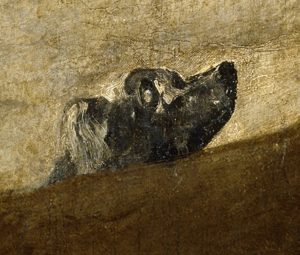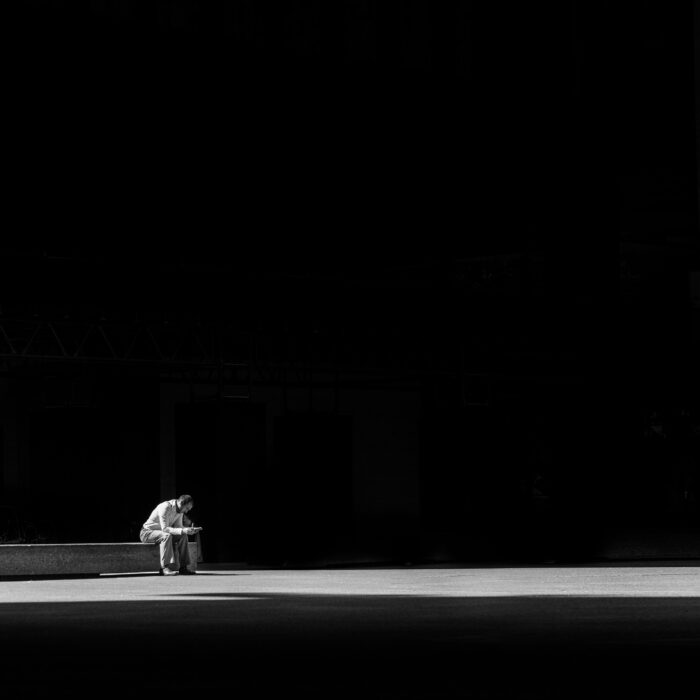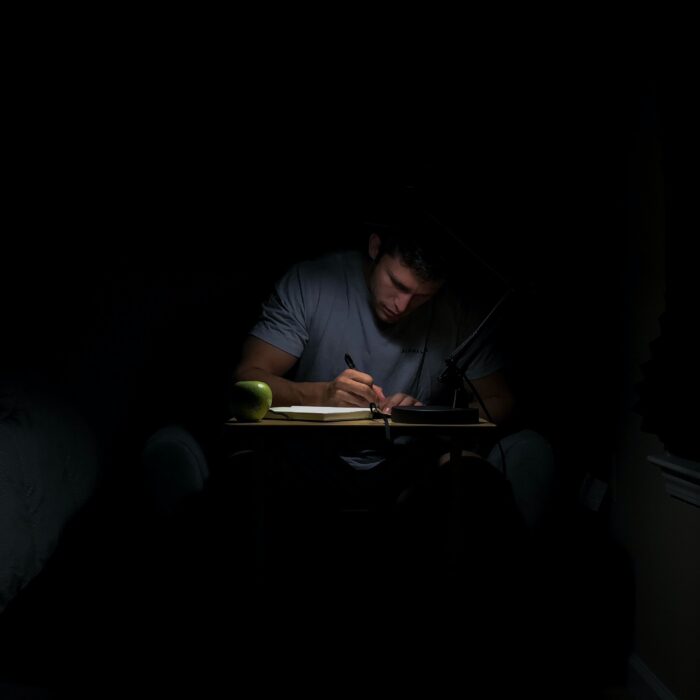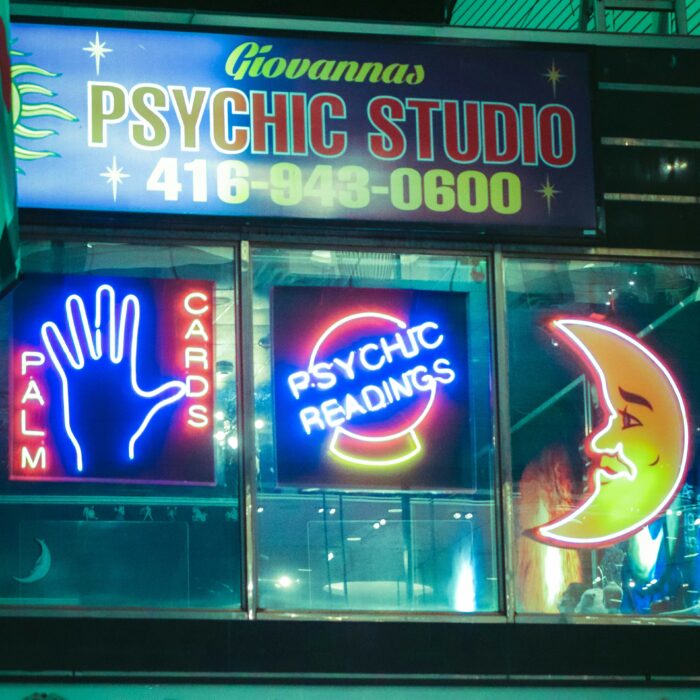You have no items in your cart. Want to get some nice things?
Go shopping I’ve always been fascinated by Goya’s work, even the creepy paintings… No, not the pictures of cannibals, witches and bandits; I mean the ones depicting inbred royals with slack-lipped smiles and vacant stares. However many times I see it, I always come back to ‘The Dog’; the timid little mutt staring out from an expanse of grey-brown canvas on the wall of Madrid’s Prado. As I pick up my pen and attempted to describe my relationship with it, it’s starting to thunder outside – fitting background music to write about one of Goya’s so called Black Paintings.
I’ve always been fascinated by Goya’s work, even the creepy paintings… No, not the pictures of cannibals, witches and bandits; I mean the ones depicting inbred royals with slack-lipped smiles and vacant stares. However many times I see it, I always come back to ‘The Dog’; the timid little mutt staring out from an expanse of grey-brown canvas on the wall of Madrid’s Prado. As I pick up my pen and attempted to describe my relationship with it, it’s starting to thunder outside – fitting background music to write about one of Goya’s so called Black Paintings.
When a sudden illness left the aging Goya almost completely deaf, he retreated to a country house near Madrid. He stayed there for around five years, mostly keeping to himself, working late into the night. The house became known as the Quinta del Sordo – The Villa of the Deaf Man. The Black Paintings, so named because of their dark palette and darker subject matter, mysterious and haunting, were painted directly onto the walls of his rooms. We must assume that they were never intended for public display. They were the product of private obsessions; scenes of violence, magic, and strange characters from some nightmarish parallel world. Amongst all this tumult, ‘The Dog’ painted, like the other murals, between 1819 and 1823, is a quiet enigma.
The structure of the painting is simple, minimal even. Two masses split the picture plane horizontally in two implying a landscape; a foreground and background, but it is dreamlike and empty. Our glimpse into this landscape is confined by the narrowness of the picture and by the mass of the foreground, which seems to form a ridge or hillside that we cannot quite see over. Our view point is low down, the horizon blocked out, so we cannot get our bearings or locate ourselves. Despite the claustrophobic composition, the close horizon of the brow of a hill implies a whole world hidden just out of view beyond it.
The dog himself is caught between earth and sky, frozen in time – trapped beyond the same ridge of foreground that shuts us out. Only his head is visible, but the first thing you notice about him is his expression: he’s looking up, afraid. What, we might ask, is scaring Fido? It is as though, just as he raised his head above the ridge, he saw something we can’t; something lurking just out of shot.
But it’s not that simple, because our little dog wasn’t always alone. There used to be something else in the frame, or rather someone else; a figure looming in from stage left, towering over our helpless little friend. Only a shadow remains, almost invisible, but once you’ve seen it, it’s impossible to ignore, in the same way that it’s impossible not to see a landscape in the two featureless expanses of canvas above and below the dog.
Faint as it is, the shape of the figure reminds me of the ones that loom over the Spanish landscapes of Goya’s ink-black dreams in paintings like ‘Fight with Cudgels’ (1820-23) or ‘The Colossus’(1808-1812). It isn’t clear whether Goya chose to paint this figure out, or if it is part of an earlier painting showing through the thinned oil paint. Was this remaining trace an accident? I think it’s a concealment; a failed deletion. Goya was attempting to eradicate something. Did he take pity on the dog, removing the source of its fear, or was there something that he didn’t want to see looking back at him from the wall of his studio?
Occasionally, I walk my dog on The Flats; a low lying area close to the town where I live that was once submerged beneath sea. At dusk, it’s an isolating experience walking there alone. As the sun sets and shadows deepen the darkness seems to grow out of the hollows and ditches as though the waters are rising again. Every now and then, the dog will freeze and stare past me, seemingly at nothing. They say animals have a sixth sense; that they can see things we can’t. When it’s dark and the wind is running through the rushes, I can’t help but wonder what he can see that I can’t. It’s that posture that I recognise in Goya’s dog. Is he staring up at a ghost that his master thought he’d exorcized?
What made the man who had once been the painter of the Spanish court paint a single lost dog? I think he was real; there is something so vivid about him that I can’t help but feel that we are seeing a glimpse of a small incident that Goya had witnessed. A frightened animal amongst all the miseries of war that Goya experienced during his lifetime; a fleeting memory that came back to haunt him when he was alone.
At the time Goya painted ‘The Dog’ his work had become even darker and more intense. He had been working on a series of etchings that we know as ‘The Disasters of War’, depicting horrific scenes from the French occupation of Spain and the Peninsular War (amongst other things, he visited many battle sites to document the Spanish resistance in drawings). It’s clear that his own experiences in this period, and those of his country had made a deep impression.
It’s dark outside my window now. The thunder has eased, but a deluge has started and the sky has darkened. On an evening like this, it’s easy to imagine him scratching away at copper plates long into the night, peering through a magnifying glass and being drawn ever deeper into the details of the trauma, madness, famine, rape and murder he was depicting.
Maybe there is something else to see in our four legged friend. During the war, Goya remained at the Spanish court, then occupied by a puppet regime headed by Joseph Bonaparte, Napoleon’s brother. After the war, his friends were seen by many as collaborators, and Goya himself ended his life in self-imposed exile in France. Some people think the dog isn’t afraid at all; they say he looks guilty. As guilty as an aging court painter who has spent his life glorifying the wrong people only to realise that, in the end, they’re all as bad as each other. But I think, when all said and done, Goya ‘s dog reflects his—our—fear of the unknown; the things just beyond the horizon that we can’t see yet.
Goya has been gone for nearly two hundred years now and ‘The Dog’ has changed since his master went. He’s not the pooch Goya once knew. For seventy years he was left neglected on the crumbling plaster walls of the Villa before, on the instructions of his new owner, Baron Émile d’Erlanger, he was taken down and laid onto canvas by caring but inexpert hands. Then came the restoration; the re-painting. Goya’s dog was lost forever, and ours is the memory of the memory. He is the product of many hands. But a little of him was saved
When I’ve walked away from all the images of massacres and witches, bandits and clashing armies and lunatics, and when the pictures of kings and gods have faded away, the image that always stays with me is of this little dog with his invisible tormentor.
About David Frankel
David Frankel’s stories have been published in anthologies and magazines, including Unthology 8, The London Magazine and Lightship Anthology. He has been short and longlisted for a number of prizes, including The Willesden Herald Short Story Prize, the Fish Memoir Prize, The Bath Short Story Prize and the Hilary Mantel Short Story Prize. He completed an MA in Creative Writing at the University of Chichester and was awarded the Kate Betts Memorial Prize. When he isn’t writing he works as an artist



